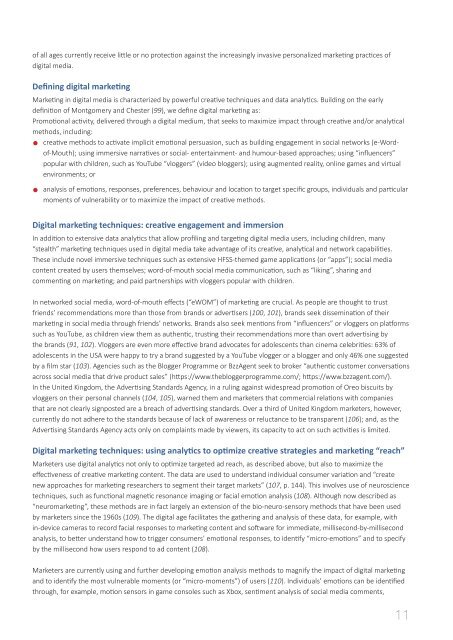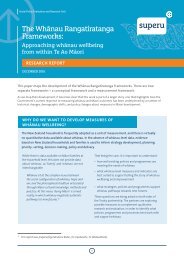2fyY1Py
2fyY1Py
2fyY1Py
You also want an ePaper? Increase the reach of your titles
YUMPU automatically turns print PDFs into web optimized ePapers that Google loves.
of all ages currently receive little or no protection against the increasingly invasive personalized marketing practices of<br />
digital media.<br />
Defining digital marketing<br />
Marketing in digital media is characterized by powerful creative techniques and data analytics. Building on the early<br />
definition of Montgomery and Chester (99), we define digital marketing as:<br />
Promotional activity, delivered through a digital medium, that seeks to maximize impact through creative and/or analytical<br />
methods, including:<br />
• creative methods to activate implicit emotional persuasion, such as building engagement in social networks (e-Wordof-Mouth);<br />
using immersive narratives or social- entertainment- and humour-based approaches; using “influencers”<br />
popular with children, such as YouTube “vloggers” (video bloggers); using augmented reality, online games and virtual<br />
environments; or<br />
•<br />
analysis of emotions, responses, preferences, behaviour and location to target specific groups, individuals and particular<br />
moments of vulnerability or to maximize the impact of creative methods.<br />
Digital marketing techniques: creative engagement and immersion<br />
In addition to extensive data analytics that allow profiling and targeting digital media users, including children, many<br />
“stealth” marketing techniques used in digital media take advantage of its creative, analytical and network capabilities.<br />
These include novel immersive techniques such as extensive HFSS-themed game applications (or “apps”); social media<br />
content created by users themselves; word-of-mouth social media communication, such as “liking”, sharing and<br />
commenting on marketing; and paid partnerships with vloggers popular with children.<br />
In networked social media, word-of-mouth effects (“eWOM”) of marketing are crucial. As people are thought to trust<br />
friends’ recommendations more than those from brands or advertisers (100, 101), brands seek dissemination of their<br />
marketing in social media through friends’ networks. Brands also seek mentions from “influencers” or vloggers on platforms<br />
such as YouTube, as children view them as authentic, trusting their recommendations more than overt advertising by<br />
the brands (91, 102). Vloggers are even more effective brand advocates for adolescents than cinema celebrities: 63% of<br />
adolescents in the USA were happy to try a brand suggested by a YouTube vlogger or a blogger and only 46% one suggested<br />
by a film star (103). Agencies such as the Blogger Programme or BzzAgent seek to broker “authentic customer conversations<br />
across social media that drive product sales” (https://www.thebloggerprogramme.com/; https://www.bzzagent.com/).<br />
In the United Kingdom, the Advertising Standards Agency, in a ruling against widespread promotion of Oreo biscuits by<br />
vloggers on their personal channels (104, 105), warned them and marketers that commercial relations with companies<br />
that are not clearly signposted are a breach of advertising standards. Over a third of United Kingdom marketers, however,<br />
currently do not adhere to the standards because of lack of awareness or reluctance to be transparent (106); and, as the<br />
Advertising Standards Agency acts only on complaints made by viewers, its capacity to act on such activities is limited.<br />
Digital marketing techniques: using analytics to optimize creative strategies and marketing “reach”<br />
Marketers use digital analytics not only to optimize targeted ad reach, as described above, but also to maximize the<br />
effectiveness of creative marketing content. The data are used to understand individual consumer variation and “create<br />
new approaches for marketing researchers to segment their target markets” (107, p. 144). This involves use of neuroscience<br />
techniques, such as functional magnetic resonance imaging or facial emotion analysis (108). Although now described as<br />
“neuromarketing”, these methods are in fact largely an extension of the bio-neuro-sensory methods that have been used<br />
by marketers since the 1960s (109). The digital age facilitates the gathering and analysis of these data, for example, with<br />
in-device cameras to record facial responses to marketing content and software for immediate, millisecond-by-millisecond<br />
analysis, to better understand how to trigger consumers’ emotional responses, to identify “micro-emotions” and to specify<br />
by the millisecond how users respond to ad content (108).<br />
Marketers are currently using and further developing emotion analysis methods to magnify the impact of digital marketing<br />
and to identify the most vulnerable moments (or “micro-moments”) of users (110). Individuals’ emotions can be identified<br />
through, for example, motion sensors in game consoles such as Xbox, sentiment analysis of social media comments,<br />
11






